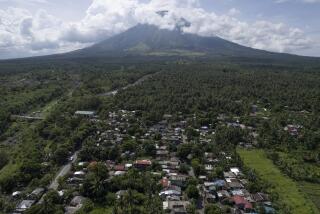Farming, Trade in Wildlife Creating Serious Ecological Problems Conservationists Fight to Save Philippines’ Last Environmental Frontier
- Share via
PUERTO PRINCESA, Philippines — The Philippines’ last environmental frontier is here in Palawan province, and conservationists are struggling to save it--from people who sell its wildlife, chop down its forests, overfish its waters and swarm in from elsewhere to burn off its land for farming.
At Puerto Princesa’s bustling market, white-breasted sea eagles are sold for less than $100 and talking myna birds for $30.
Immigration from other islands, which has grown by an average of 5% since the start of the decade, has reduced the percentage of Palawan’s original settlers--including at least seven native tribes--to less than half of the population, now estimated at 500,000.
The influx has created serious ecological problems, among them the slash-and-burn farming methods of poor settlers and the vigorous collection of wildlife for sale. Wealthy logging concessionaires have been accused of plundering the province’s timber resources.
Mountains run the length of the province’s main island, on which are found 232--or one-fifth--of the country’s wildlife species, environmentalists say. Many of the species are yet to be classified.
Largest Province
Palawan, the Philippines’ largest province, is about 150 miles southwest of Manila. It is also home to about 1,500 species of plants whose medicinal and food properties have not been fully examined.
More than 1,700 islands offer 2,000 miles of coastline. Waters teem with fish. The provincial environment office says nearly 50 million metric tons of fish were caught in 1987 alone.
Human fossils 22,000 years old have been found in the province’s Tabon Cave.
The Haribon Foundation, a conservationist group, has gathered 1 million signatures since last year to pressure the government into declaring Palawan a protected area.
In a recent letter to President Corazon Aquino, Haribon President Maximo Kalaw urged a ban on commercial logging and collection of wildlife in Palawan. Haribon also urged the establishment of communal forest areas for island residents.
Aquino referred the petition to the Department of Environment and Natural Resources.
“The issue in Palawan is not only about conservation but about social equity and sustainable development for generations of Filipinos to come,” Kalaw said.
Nearly 70% of Palawan’s land area of 3.7 million acres is forested. Haribon blames loggers, whose concessions cover one-fifth of forest lands, for denuding an estimated 46,930 acres of forests yearly.
The destruction of natural forests has resulted in soil erosion, siltation and flooding in the southern part of the province, district foresters said.
Few Guards for Forests
Officials say they lack resources to protect the forests. Mariano Villanueva, provincial environment and natural resources officer, says he has only 179 guards, each responsible for 9,880 acres of forest.
The illegal use of cyanide and dynamite by fishermen threatens fish stocks and the coral offshore. Villanueva says his agents cannot arrest fishermen suspected of using cyanide because they have no equipment to detect the poison.
Aside from cyanide and dynamite, local fishermen use a technique called “ muro-ami “ fishing, in which they drive poles into the coral to divert fish into their nets.
Brig. Gen. Napoleon Angeles, the regional military commander, has seized boats and other marine equipment to discourage illegal fishing. But he opposes a logging ban for fear that it would result in higher unemployment and possibly fuel the Philippines’ years-long Communist insurgency, which has just recently made its way to Palawan.
“I am for a sustainable use of natural resources so people may eke out some kind of livelihood program for themselves,” said Angeles, a member of the provincial development council.
A British consulting firm, Hunting Technical Services, and local agencies have developed an environmental plan for the Palawan Integrated Area Development Project.
The plan recommends a 20% reduction in the area authorized for logging each year to prolong the cutting cycle and protect against erosion.
Currently, timber companies may operate on about 12,350 acres a year. The plan calls for stricter monitoring of these companies.
Officials have also stepped up the campaign against illegal logging.
Although Palawan was declared a game refuge and bird sanctuary in 1967, trading of wildlife continues. Officials recently raided the public market and retrieved an eagle, green parrots, porcupines and myna birds.
They arrived too late to save a leopard--it had died in a cage--and a rare bearcat, which they found hanging from a nail.
More to Read
Sign up for Essential California
The most important California stories and recommendations in your inbox every morning.
You may occasionally receive promotional content from the Los Angeles Times.










